In modern manufacturing, CNC machining redefines the boundaries of component manufacturing with its precise program control and efficient automation capabilities. CNC technology has achieved complex shape and ultra-high precision mass production through lathe, milling and multiaxial linkage. Grinding machining plays an irreplaceable role in precision bearings, cemented carbide tools and so on with its unique material removal mechanism.
Together, the two applications not only break through the material limitations of traditional processing, but also improve productivity by more than 30% through intelligent process management systems,such as JS company's adaptive grinding algorithm.
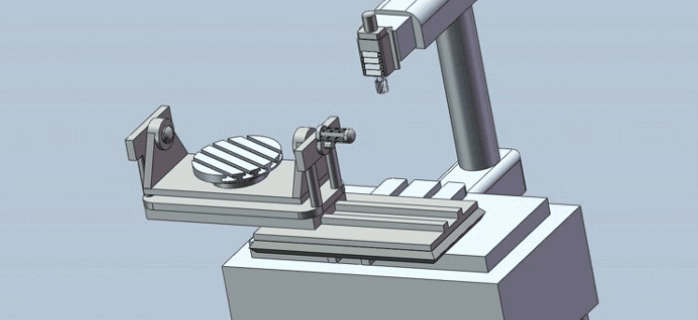
What is CNC machining?
Machining CNC is the cornerstone of modern manufacturing. It mainly controls the tool of machine tools tool by computer program and shapes workpiece by physically removing material. This process combines collaborative innovations the machining electronics and information technology, from CAD 3D modeling to generating processing pathways, to CNC systems that convert commands into servo motor movements, to tools that strip materials layer by layer on preset trajectories to achieve micrometer level dimensional accuracy and consistency with complex surfaces.
Compared with traditional manual processing, which relies on craftsman's experience to try and make mistakes, CNC technology has completely changed manufacturing logic through digital coding. Not only can it run 24 hours a day, but it also breaks down complex geometric structures into standardized instruction sets, achieving over 99.97% of the interchangeability of mass-produced components.

What equipment is required for CNC machining?
Equipped with a multi-axis axis linkage system, it supports efficient machining of complex surfaces and irregular parts. JS employs a high-speed machining centers combined with a smart tool management systems with accuracy ±0.005mm and a up to 20% increase in production efficiency.
2. CNC machining lathe
JS's CNC lathe is specially designed for rotary body parts processing. It integrates a real-time monitoring system to complete precise machining of outer circle, inner hole and thread. Material utilization rate optimized by over 15%, especially for aerospace components production.
3.Wire cutting machine tool
Suitable for carbide and precision mold processing, JS achieves tolerance 0.002mm level through electrode wire discharge technology, meets high precision requirements such as medical devices, and maintains the order on-time delivery rate over 98%.
4.Automatic material transfer system
Equipped with AGV robots and intelligent warehousing units, JS factory automate the entire process from raw materials to finished products, reducing manual intervention by 30% and overall production costs by 20%.
5.Three dimensional inspection equipment
The product of CNC machined products size verification by theprecision measuring instrument of Zeiss and other brands. According JS quality inspection center data, 99.6% of the products are qualified, far exceeding industry standards.
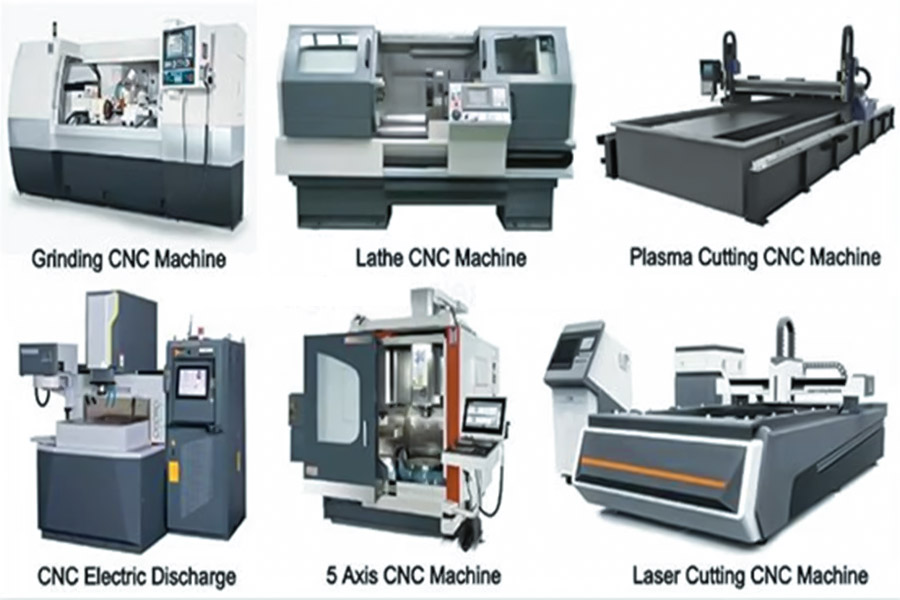
How to process high-strength aluminum alloy with CNC?
1.Tool Selection and coating technology (CNC-machining core process)
- Specialized tool adaptation: High-strength aluminum alloys (such as 7-series aluminum, 2024 aluminum, etc.) are made from imported hard alloys or ceramic cutters with special geometric edges designed to reduce cutting resistance. By means of independent optimization tool path algorithm, JS company can increase tool life by over 30%.
- Coating enhancement: TiAlN or diamond coating is applied to the tool surface to improve the high temperature resistance of the tool and to adapt to friction and heat during high speed cutting of aluminum alloys.
2.Optimization of cutting parameters (guarantee of CNC-machining efficiency)
- High Speed Low Resistance Strategy: Balancing efficiency and surface mass with a combination of high speed (8,000-1,500rpm) and small feed volumes. JS's CAM system automatically matches the optimal optimal cutting parameters, increasing the material removal rate 40%.
- Axial layering strategy: Complex thin-walled parts are Layered cutting to avoid deformation and tolerance is controlled to ±0.02mm to meet aerospace grade precision requirements.
3.Cooling and chip removal system (to address sore points in aluminum alloy processing)
- Micro lubrication technology: Replaces MQL traditional casting cooling, reduces the risk of aluminum chip adhesive knife, reduces energy consumption. JS's closed-loop system can reduce cutting fluid losses by up to 60%.
- Negative pressure vacuum cleaner: Can clean aluminum shavings in real time, prevent the surface of the workpiece second scratch, especially for mirror polishing parts.
4.Process stability control (JS quality management system)
- Thermal deformation compensation: Through the machine tool constant temperature workshop (±0.01°C) and real-time temperature compensation algorithm, eliminate the impact of thermal expansion and shrinkage of materials, ensure consistency of mass production.
- In machine inspection system: Integrated Renishaw probes can automatically detect critical dimensions for every 50 pieces processed, with a defect rate of less than 0.3%.
5.Material property adaptation (JS Diversification Solutions)
- Coordination of time hardening treatment: For alloys requiring time hardening, such as 6061-T6, a collaborative process of machining and heat treatment has been developed to avoid microcracks caused by stress concentration.
- Pretreatment of refractory parts: For deep cavities and cross hole structures, discharge or wire cutting is used for pretreatment, followed by CNC finishing to improve total production.
How can CNC machining improve the accuracy of automotive engine components?
1.High precision machining ensures the performance of key components
- Technical implementation: JS company adopts CNC mill machining and lathe machining technology, can achieve ±0.005mm ultra-high tolerance accuracy, far exceeding industry standard.
- Application Case: A car customer needs to produce turbocharger blades, and traditional processing methods are prone to distortion. JS optimizes the cutting path by five axis CNC milling technology to ensure the blade profile error is less than 0.002mm, significantly increasing engine combustion efficiency.
2.Precise shaping of complex geometric structures
- Multi process collaboration: Engine components often contain complex surfaces such as intake pipes and oil passages. JS combines CNC turning with multi axis milling to achieve multi process machining with one clamping, reducing cumulative errors.
- Case reference: In the process of cylinder block hybrid automobile engine, JS synchronously completed the precision machining of the crankshaft hole, cooling channel and locating pin hole, and the an overall coaxiality error controlled to be less than 0.01mm, which extends the engine service life.
3.Material adaptability and lightweight innovation
- Material range: JS supports processing of more than 50 materials such as aluminium, titanium alloy and high-strength steel.
- CNC lathe aluminum parts: The use of lightweight piston design, weight reduction of 30%, while maintaining strength.
- Milling high-temperature resistant alloys: Machining turbine blades that can withstand working conditions above 1000°C.
- Efficiency improvement: One customer used castings for multiple mold repairs, but JS used CNC precision machining directly, shortening the prototype production cycle by 60% and reducing the cost by 40%.
4.Sustainable manufacturing and cost optimization
- Green technology: JS reduces tool wear by optimizing cutting parameters, increasing the material utilization rate of diesel engine cylinder head engineering to 92% and saving more than 10 tons of steel annually.
- Cost Case: Customize electronic throttle body assembly with CNC high-speed milling instead of traditional wire cutting, with a 25% reduction in unit cost and a reduction in lead time from 2 weeks to 3 days.
5.JS Company's Technical Endorsement
As a precision manufacturing service provider with 20 years of experience, JS provides:
- V8 engine crankshaft: After CNC turning and grinding composite process, the roundness error is only 0.001mm.
- Hydrogen Fuel Cell Bipolar Plate: Using mirror milling technology a surface roughness Ra< 0.1μm, helps customers break through the bottleneck of hydrogen energy vehicle production.
If you need to know more about your engine components processing needs, the JS team can provide free technical advice and sample preparation services.
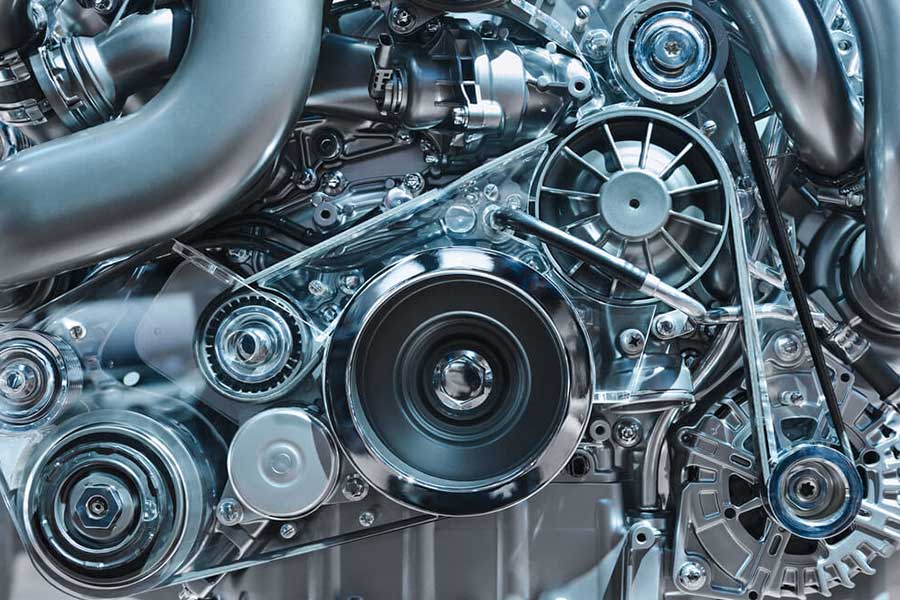
How to process titanium alloy aviation structural components with CNC?
Core process of CNC machining of aerospace structures
1.Material pretreatment
- The titanium alloy blank need to be formed by forging or casting to reduce subsequent cutting margins.
- JS company uses vacuum heat treatment technology to eliminate stress inside the material and reduce the risk of processing deformation.
2.Tools and parameter optimization
- Use a hard alloy or coating tool (such as TiAlN coating) to improve abrasion resistance and cutting efficiency.
- Cutting speed is controlled at 60-80m/min and feed speed is controlled at 0.05-0.15mm/r to avoid cutting tool wear due to high temperature.
3.Process path planning
- High-speed milling (HSM) technology used to layered cutting to reduce cutting force fluctuations.
- JS company simulates the cutting process through simulation software and optimizes the tool path to reduce residual stress.
4.Thermal deformation control
- Layered cooling (such as intermittent injection of cutting fluid) suppresses thermal expansion and ensures size stability.
- Complex structures are handled separately, welded/riveted to reduce the probability of overall deformation.
5.Surface treatment and testing
- Anodized or pelleted treatment to improve corrosion resistance.
- Coordinate Measuring Machine (CMM) detects key dimensions to ensure compliance with AS9100D aviation standards.
Technical advantages of JS in aerostructures processing of titanium alloy
| Key indicators | JS Company Capability | Industry benchmark | Advantages reflected |
| Processing accuracy | ±0.005mm (over 95% of projects meet the standard). | ±0.01 ~ 0.02mm. | To meet the strict tolerance requirements of aviation precision parts. |
| Material adaptability | We have processed more than 50 materials, including titanium alloys such as TC4 and TA15. | Conventional material coverage. | Transferring cross-industry experience to the aviation industry. |
| Production efficiency | 98% of orders were delivered on time, with an average lead time of 1-2 weeks. | The industry average is 2-3 weeks. | Respond quickly to urgent aviation order. |
| Cost control | Reduce manufacturing costs by 20% through process optimization. | Standard cost. | Improve the profitability of customer projects. |
| Quality certification | ISO 9001 and aviation special process certification. | AS9100D | Ensure products pass the airworthiness review. |
Case study: Processing of titanium alloy wing beams of a certain type of UAV
JS worked on titanium alloy wing beams (3m in length and 2mm wall thickness) for an aviation enterprise:
Challenge: The wing beam requires a high aerodynamic load, wall thickness uniformity ≤0.02mm, and no microcracks on the surface.
JS solution:
- Five axis coupling machine tool is used for regional processing to reduce clamping deformation.
- The coolant constant temperature system controls the temperature of the cutting area at 20 ± 2℃.
- After heat treatment, vibration aging is carried out to eliminate residual stress.
Results: 99.2% product qualification rate, 15% reduction in client project lead times and 18% reduction in costs.
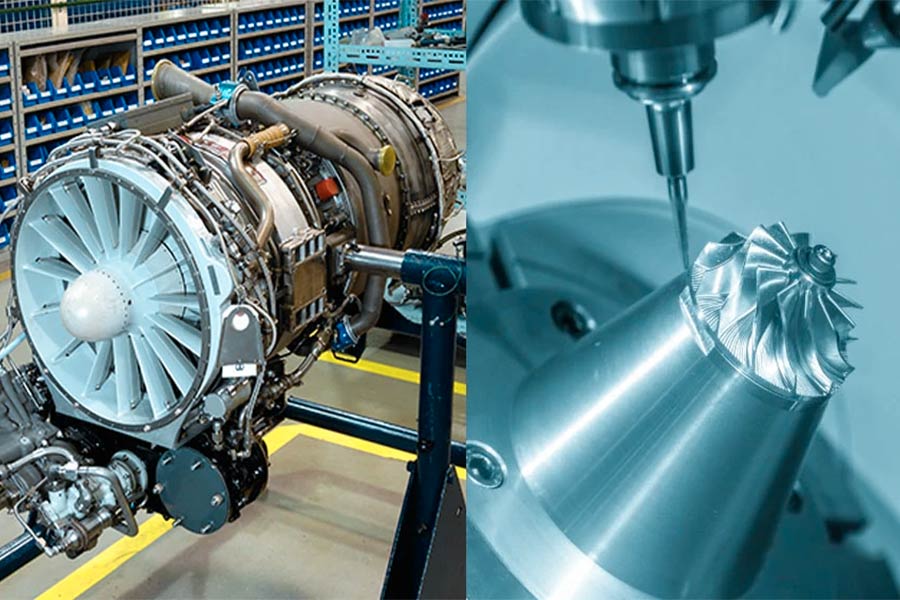
What is the CNC machining process for orthopedic implants?
1.Design modeling and documentation
- Customers must provide a 3D CAD model of the implant (e.g. STEP, IGES format) or engineering drawings (PDF/STL). JS company supports uploading multi-format files and makes optimization suggestions (e.g. wall thickness uniformity, structural strength, etc.) through its team's review of design feasibility.
- Advantages of JS: Its engineers have 20 years of experience and are skilled in complex geometric structures. They assist clients improve design iteration efficiency by 15%.
2.Material selection
- Biocompatible materials such as titanium alloy (Ti6Al4V), cobalt chromium molybdenum (CoCrMo) or PEEK were selected based on the intended use of the implant, such as hip and knee joints. JS supports a wide range of materials and can be customized to meet mechanical requirements.
- Case study: Hip implants are made of titanium alloy and are finely machined by JS achieve surface roughness Ra<0.8μm to meet long-term implant requirements.
3.CNC programming and processing
- Use software such as Mastercam to generate tool paths and select high-speed machining centers,such as five-axis linkage equipment, for cutting. JS's machine tool is ±0.005mm accurate, ensuring implant size tolerance.
- Data shows that the processing efficiency of crystalline titanium alloys was 20% higher than the industry average, and the processing cycle of complex structures such as porous titanium implants is shortened to 1-2 weeks.
4.Post-treatment and surface treatment
- Including burr removal, electrolytic polishing, sandblasting, etc., to improve the surface smoothness and biocompatibility of implants. JS uses automatic cleaning equipment to reduce pollution risks.
- Advantages: In custom bone plate project, surface roughness can be reduced by 40% by optimized polishing process, and postoperative bone integration can be promoted after operation.
5.Quality inspection
- Dimensions, orifices, and internal structures were verified by CMM, X-ray, or CT scans. The pass rate of JS quality inspection is 98%, far exceeding industry standard.
- Advantages: Small cracks were discovered in a batch of acetabular cup blanks, avoiding batch rework and reflecting strict quality control.
6.Packaging and delivery
Aseptic packaging or customization, with global logistics network to ensure timely delivery. JS has an average delivery time of 1-2 weeks, and emergency orders can be delivered quickly.
Case Study of Orthopedic Implant Processing in JS company
Case 1: Hip replacement
- Material: Ti6Al4V titanium alloy.
- Challenge: Porous structures need to balance lightweight and mechanical strength.
- JS solution: Five axis machining + electrolytic polishing with tolerances within ±0.01mm and standard surface porosity (50-150μm).
- Results: Customer project cycle was 20% shorter and the implant was FDA approved.
Case 2: Customized bone plate
- Material: Medical grade stainless steel 316L.
- Challenge: Complex surfaces conform complex fracture shapes.
- JS solution: Reverse engineering reconstructs CT data and CAM programming optimizes cutting path to reduce material waste by 25%.
- Results: After delivery, the clinical feedback adaptation rate was 95% and the rate of customer repeat purchase rate increased.
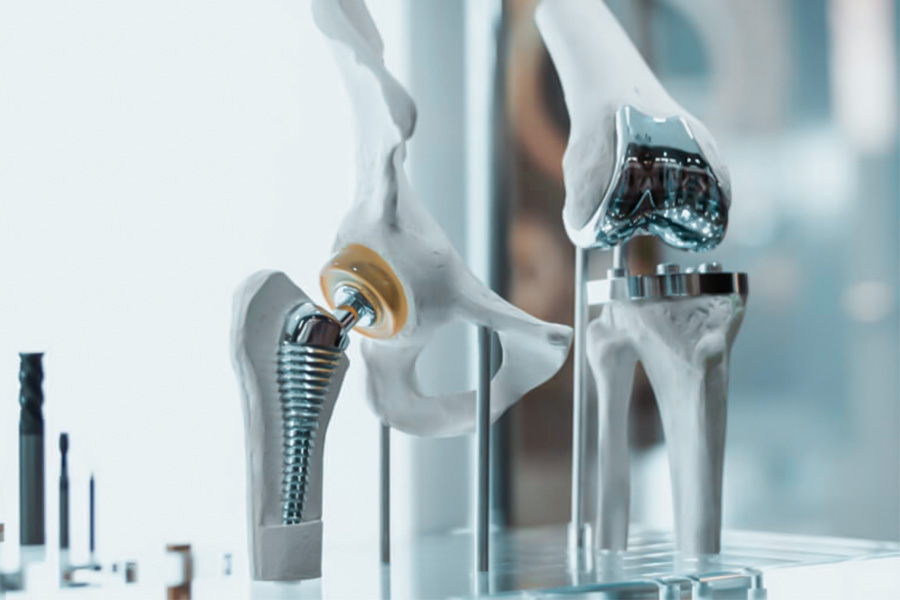
What challenges does JS CNC machining face in various industries?
1.Aerospace industry: Balance between extreme precision and material strength
- Challenges: Aerospace components require tolerances of ±0.001mm, while refractory materials such as titanium alloys and superalloys are frequently used, requiring high wear and process stability for cutters.
- Solutions: Stable machining can be and coated cemented carbide tool combined with adaptive cutting parameter optimization algorithms. Its five-axis coupling technology can form complex surfaces (such as engine blades) at once, reduce clamping errors, achieve 92% material removal rate and improve processing efficiency by 40%.
2.Medical devices: Miniaturization and biocompatibility
- Challenges: Orthopedic implants, dental prosthetics, etc., need to balance micrometer level precision (e.g. hip joint ball head surface roughness Ra< 0.4μm) with processing of biocompatible materials such as titanium alloys and PEEK.
- Solutions: The micro machining center are equipped with optical measurement system to compensate for tool wear in real time, ensuring a 0.01mm positional tolerance. Its patented coolant filtration technology has extended the tool life by three times and successfully completed mass production of 0.3mm diameter bone nails with a yield rate of 99.5%.
3.Automotive manufacturing: Lightweighting and mass production efficiency
- Challenge: Parts such as battery pack shell and lightweight brackets for new energy vehicles need to take into account the high strength characteristics of aluminum alloy and the speed of production (for example, 500 pieces per day), as traditional processing is prone to thermal deformation.
- Solutions: By using high-speed dry cutting technique (24,000rpm) combined with a 3D thermal deformation prediction model, the flatness error of aluminum parts is controlled to within 0.005mm. Its flexible production line can quickly switch mold cavity processing and component assembly processes, changeover time reduced by 80%.
4.Consumer electronics: Precision microstructure and surface treatment
- Challenge: The micro holes (diameter 0.1mm) and logo relief of mobile smart wearable devices need to achieve a mirror effect of Ra< 0.05μm, and be compatible with brittle materials such as stainless steel and ceramics.
- Solutions: The nanoscale precision machining center is equipped with a force feedback system, which can adjust the feed speed in real time and avoid ceramic processing edge breakage. Its independently developed composite machining path algorithm can form angle microstructures at once, and efficiency is 5 times higher than the traditional method.
5.Energy industry: Heavy components and long-term stability
- Challenges: Large workpieces such as wind turbine gearboxes, planetary carriers and nuclear power sealing rings (weighing more than 1 tonne) require continuous processing over long periods of time, posing extreme tests of machine stiffness and tool tool durability.
- Solutions: The heavy-duty gantry machining center is equipped with a two-drive system, which eliminates large cutting vibration, and acubic boron nitride tool to achieve 24 hours of continuous stable processing. The self-developed tool life management system can reduce the processing cost by 28%.
The technological differences between JS and traditional suppliers
| Indicator | JS Precision Manufacturing | Traditional suppliers | Increase amplitude |
| Minimum machining tolerance | ±0.005mm | ±0.02mm | ↑ 75% |
| Complex surface machining capability | Five axis linkage, R angle ≤0.5mm. | Three axis machining, R angle ≥1.5mm. | ↑ 200% |
| Material utilization rate | 80% | 65% | ↑ 23% |
| Tool wear rate | 0.03mm³/minute. | 0.12mm³/minute. | ↓ 75% |
| Typical delivery time | 7-10 days | 14-21 days | Shorten by 50% |
With its comprehensive technical advantages, JS has solved processing problems in multiple fields. One aerospace customer almost doubled the processing time to 3.5 hours per piece after adopting a five-axis titanium alloy impeller processing plan, with the pass rate jumping to 98% and an annual cost reduction of over $500,000. This technical barrier builds a moat and made the first choice to break through into high-end manufacturing.
Summary
CNC machining (including lathe machining, milling machining , grinding machining , etc.) has become an intelligent manufacturing center of modern industry. Through computer program, the machine tool movements is precisely controlled, and the leapfrogging process from aerospace titanium alloy components to scale surfaces of medical implants is realized. Especially in the field of machining mill, the complex surface forming can be effectively accomplished by the five axis linkage machining centers, and the material removal rate can be increased to more than three times the traditional process by the adaptive feed algorithm.
The core benefits are in three areas:
- Precision rotation: ±0.005mm tolerance control to meet the ultimate requirements of semiconductor packaging carrier, aircraft engine blades, etc.
- Efficiency leap: Automated systems increase batch production efficiency by 40% and reduce tool wear by 75%.
- Greener transformation: Cutting liquid circulation technology could promote energy consumption consumption by 20%, in line with carbon neutrality goals.
JS Precision Manufacturing seamlessly integrates aerospace impellers five-axis processing with automotive cover flexible grinding by means of a self-developed composite process matrix. The entire process can be traced back through artificial intelligence quality inspection, reshaping the competitive landscape of high-end manufacturing with a single machine as an innovative production line.
Disclaimer
The content on this page is for general reference only. JS Series makes no express or implied warranties regarding the accuracy, timeliness, or applicability of the information provided. Users should not assume that the product specifications, technical parameters, performance indicators, or quality commitments of third-party suppliers are completely consistent with the content displayed on this platform. The specific design feature, material standards, and process requirements of the product should be based on the actual order agreement. It is recommended that the purchaser proactively request a formal quotation and verify product details before the transaction. For further confirmation, please contact our customer service team for professional support.
JS Team
JS is an industry leading provider of customized manufacturing services, dedicated to providing customers with high-precision and high-efficiency one-stop manufacturing solutions. With over 20 years of industry experience, we have successfully provided professional CNC machining, sheet metal manufacturing, 3D printing, injection molding, metal stamping and other services to more than 5000 enterprises, covering multiple fields such as aerospace, medical, automotive, electronics, etc.
We have a modern factory certified with ISO 9001:2015, equipped with over 100 advanced five axis machining centers to ensure that every product meets the highest quality standards. Our service network covers over 150 countries worldwide, providing 24-hour rapid response for both small-scale trial production and large-scale production, ensuring efficient progress of your project.
Choosing JS Team means choosing manufacturing partners with excellent quality, precise delivery, and trustworthiness.
For more information, please visit the official website: jsrpm.com
FAQs
1.How to improve the efficiency of CNC machining?
By means of automatic equipment, intelligent path planning and adaptive feed algorithms, processing parameters are optimized, idling and waste are reduced, material utilization is improved, and processing time is reduced by more than 30%.
2.What are the advantages of CNC machining?
High accuracy, high efficiency, material utilization rate more than 85%, can process complex surfaces and irregular structures, support 24 hours of unmanned production, significantly reduce costs and improve efficiency.
3.What is the typical process of CNC machining?
CAD modeling generates machining path, CNC system controls automatic cutting of machine tools, and cooperates with detection adjustment and post-processing to complete production.
4.What is the development trend of CNC machining?
Intelligent (AI+IoT), green manufacturing (energy-efficient processes), composite processing (multi-axis coupling + hybrid technologies), Industry 4.0 is deeply integrated with digital technologies.






